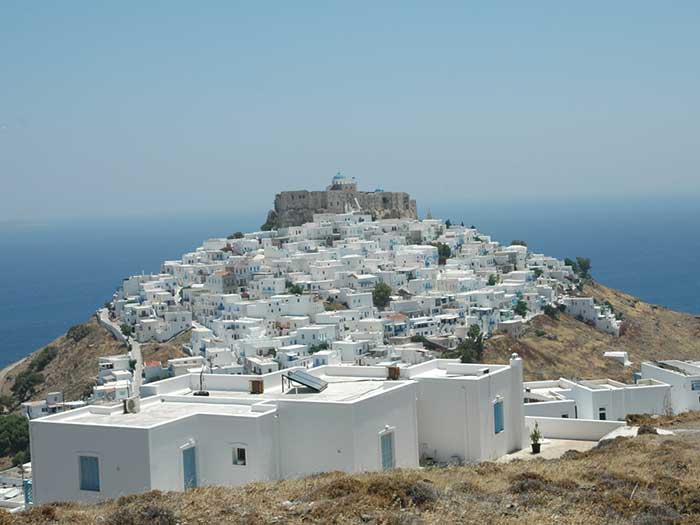A model island for e-mobility in the Aegean Sea
The Greek island of Astypalea is aiming to become a model for smart, emission-free mobility. All of its 1,500 or so combustion-engine vehicles will be replaced, and an adequate infrastructure for private and public charging, powered by green energy, will be built.

A Greek island in the Aegean Sea, Astypalea has been mainly known for its butterflies until now. But that could all change in the future, with many more people set to hear about the island thanks to a joint project with Volkswagen Group to make its transport system purely electric.
About 1,300 people live on Astypalea; in addition, more than 70,000 tourists visit the island every year. Overall, there are about 1,500 vehicles, which are used for every type of journey – all powered by combustion engines. This will change radically from next year, when Astypalea will begin converting its vehicle fleet to e-vehicles, potentially making it the first region in the world to achieve completely emission-free traffic.
“Through this cooperation we want to show how an international business enterprise, a local community and a European state can work together for the benefit of the people,” commented Konstantinos Fragogiannis, Deputy Foreign Minister of Greece.
Mobility that's electric...
Astypalea has joined forces with the automotive Group and the Greek government: Prime Minister Kyriakos Mitsotakis and Volkswagen CEO Herbert Diess signed a Memorandum of Understanding on November 4 to develop an integrated electric mobility system. Traffic on the island will be converted to e-mobility.
This includes the public transport system, local authority vehicles (police, paramedics), company vehicles, and inhabitants’ private vehicles. At the same time, a network of private and public charging infrastructure will be created.
...and smart
In addition, new car-sharing and ride-sharing services will replace the old bus network (comprising only two routes with limited frequency), and will serve all corners of the island throughout the year. The island is targeting around 1,000 electric vehicles, while boosting usage levels.
“We want to show that it is possible to achieve a higher level of individual mobility with fewer vehicles, and in a way that is climate neutral,” spelled out Maik Stephan, Head of Business Development at Volkswagen Group.
Green energy
Currently Astypalea gets its electricity almost entirely from diesel generators. These are due to be deactivated within two years (although they will remain operational in case of emergencies). Electricity demand from households, companies and traffic will be met by wind and solar power systems that the Greek government will install on the island alongside batteries to store the energy.
The electric fleet will be powered entirely by green, renewable electricity. E-vehicles are expected to be deployed from the first half of 2021, with the first expected to be government vehicles and those for sharing services. Private vehicles will follow – they will be sold through dealerships as normal, with customers benefiting from government subsidy programs.
Ideal conditions
Astypalea offers ideal conditions for a project of this kind. The island is starting virtually from scratch, and is thus making a complete transformation in terms of mobility. It also offers a clearly defined and closed area without external limiting factors. It is also just the right size to test out an innovative transport system efficiently and observe its impact on the community. And the locals also greeted the idea with enthusiasm from the very beginning.
“We ruled out large islands like Crete or Rhodes for cost reasons, and very small islands with a few hundred people were also out of the question because the results would not be representative. Astypalea, however, is the perfect choice,” explained Fragogiannis, before adding that an area where autonomous driving could be tested in the future would also be identified.
Greece
Greece is bowing out of coal by 2028, with the majority of its power plants set to be decommissioned as early as 2023. Instead, the government is promoting wind turbines, solar plants and other climate-friendly technologies. The cooperation with Volkswagen Group is a beacon in this respect. Astypalea can become an ecological model for many islands all over the world.
Volkswagen's commitment
The Volkswagen Group’s commitment to this project is crucial. It provides a real-life opportunity to show and test how electric mobility can already be a climate-friendly solution that doesn’t involve any compromises. The cars featuring in the island’s transformation will be the e-up!1, the ID.32 and the ID.43, as well as vehicles from Volkswagen Commercial Vehicles.
Very different customer groups interact on Astypalea – on the one hand the locals, and on the other thousands of tourists who only spend a short time on the island. By observing the similarities and differences between the two groups, mobility services can be further improved.
1) e-up! – Power consumption in kWh/100 km (NEDC): 12.9–12.7 (combined); CO2 emissions in g/km: 0; efficiency class: A+
2) ID.3 – power consumption in kWh/100 km (NEDC): 15.4-14.5 (combined); CO2 emissions in g/km: 0; efficiency class: A+
3) ID.4 – power consumption in kWh/100 km (NEDC): 16.9-16.2 (combined); CO2 emissions in g/km: 0; efficiency class: A+
Source: Volkswagen Newsroom
